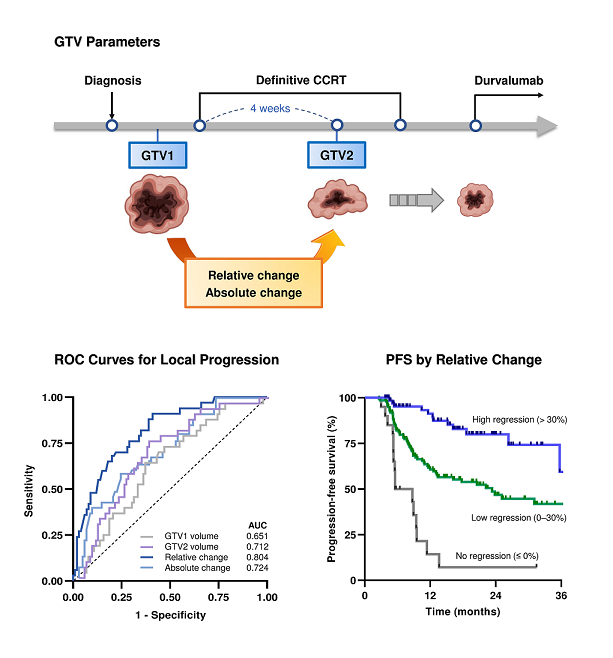글로벌 연구동향
방사선종양학
- 2024년 11월호
[Radiother Oncol .] Predictive value of primary tumor volume change during concurrent chemoradiotherapy in patients with unresectable stage III non-small cell lung cancer울산의대 / 이혜인, 송시열*
- 출처
- Radiother Oncol .
- 등재일
- 2024 Sep:198:110383. doi: 10.1016/j.radonc.2024.11
- 저널이슈번호
- 내용
Abstract
Background and purpose: No established early biomarkers currently exist to predict responses during concurrent chemoradiotherapy (CCRT) in patients with unresectable non-small cell lung cancer (NSCLC). This study investigated the potential of gross tumor volume (GTV) and its changes during CCRT as predictors of survival outcomes.Materials and methods: We identified 227 patients with unresectable stage III NSCLC who underwent definitive CCRT followed by durvalumab between November 2018 and December 2022. GTV was defined as the volume of the primary tumor, assessed at two time points: before starting CCRT for initial planning (GTV1), and at the fourth week of CCRT for adaptive planning (GTV2). Both relative and absolute regressions between GTV1 and GTV2 were calculated.
Results: The median GTV1 volume was 90 mL (range, 5-840 mL), and the median GTV2 volume was 64 mL (range, 1-520 mL), resulting in median absolute and relative regressions of 18.6 mL and 25.0 %, respectively. Among the GTV parameters, relative GTV regression exhibited the strongest predictive value, with an area under the curve (AUC) of 0.804 for in-field progression and 0.711 for overall progression. The 1-year progression-free survival rates for the high (>30 %), intermediate (0-30 %), and low (≤0%) relative regression groups were 88.0 %, 62.6 %, and 14.3 %, respectively (p = 0.006 for high vs. intermediate; p < 0.001 for intermediate vs. low). Additionally, GTV2 volume demonstrated stronger associations with survival outcomes than GTV1 volume.
Conclusion: Relative GTV regression was identified as a promising early predictor for patients with unresectable stage III NSCLC. Further development of a multi-parametric predictive model is warranted to guide patient-tailored therapeutic approaches.

Affiliations
Hye In Lee 1, Eun Kyung Choi 1, Su Ssan Kim 1, Young Seob Shin 1, Jae Won Park 2, Si Yeol Song 3
1Department of Radiation Oncology, Asan Medical Center, University of Ulsan College of Medicine, Seoul, Republic of Korea.
2Department of Radiation Oncology, Yeungnam University Medical Center, Yeungnam University College of Medicine, Daegu, Republic of Korea.
3Department of Radiation Oncology, Asan Medical Center, University of Ulsan College of Medicine, Seoul, Republic of Korea. Electronic address: coocoori@amc.seoul.kr.
- 키워드
- Biomarker; Concurrent chemoradiotherapy; Gross tumor volume; Non-small cell lung cancer; Tumor response.
- 연구소개
- 본 연구는 비소세포폐암 환자들의 방사선 치료기간중 종양 용적 변화가 장기적 치료 효과를 예측하는 지표로써 활용될 수 있을지 그 가능성을 평가한 연구입니다. 2018년부터 2022년까지 비소세포폐암 3기로 진단되어 동시항암화학방사선치료 및 두발루맙 치료를 시행받은 환자 227명의 데이터를 분석했습니다. 본 기관에서는 비소세포폐암으로 방사선치료를 받는 모든 환자에서 치료 전과 치료 4주차에 각각 CT 시뮬레이션을 시행하여, 초기 종양 및 변화된 종양 크기를 반영한 두 번의 치료계획을 수립합니다. 따라서 이를 기반으로 한 네 가지 파라미터의 예측 기능을 평가하였습니다 (첫 시뮬레이션의 종양 부피 [GTV1], 두 번째 시뮬레이션의 종양 부피 [GTV2], 종양 부피의 절대적 감소치와 상대적 감소치; 첨부된 그림 참조). 분석 결과, GTV1의 중앙값은 90mL, GTV2의 중앙값은 64mL였으며, 네 가지 파라미터 중 상대적 감소율이 가장 강력한 예측 지표로 확인되었습니다 (국소 진행 AUC 0.804, 전체 진행 AUC 0.711). GTV의 상대적 감소율이 가장 높은 그룹(>30%)의 1년 무진행 생존율은 88.0%로, 중간 감소 그룹(0-30%)의 62.6%, 그리고 감소를 보이지 않은 그룹(≤0%)의 14.3%에 비해 유의하게 높았습니다 (P<0.001). 종합하면, 본 연구 결과는 방사선 치료기간 중 종양 부피의 변화, 특히 상대적 감소율은 장기적인 치료 반응을 예측하는 조기 바이오마커로써 활용될 수 있으며, 이를 통해 환자 맞춤형 치료 전략을 수립하는 데 기여할 수 있음을 시사했습니다.
- 덧글달기








편집위원
비소세포폐암의 동시항암방사선치료 시 방사선치료 전의 육안적종양체적(GTV1)과 치료 4주차의 GTV2 변화를 분석하여 예후 예측 가능성을 확인한 연구입니다. 방사선치료 중에 흔히 GTV의 감소가 관찰되므로 adaptive planning을 위한 CT를 촬영하게 되는데, planning CT에서 확인할 수 있는 GTV 감소 정도를 통해 무병생존율의 관계를 확인하였고, GTV2가 치료 성적에 더 관련이 있다고 보고한 바, 이 연구에서 사용된 방법론이 임상에서 그리 어렵지 않은 것으로 보이며, 이를 통해 조기에 예후 예측을 해볼 수 있을 것으로 보여 흥미롭습니다.
덧글달기닫기2024-10-18 14:32:50
등록
편집위원2
본 연구는 절제 불가능한 3기 비소세포성 폐암(NSCLC) 환자에서 concurrent chemoradiotherapy (CCRT) 중 종양 부피 gross tumor volume (GTV) 변화를 생존율 예측 지표로 사용할 수 있는지 조사했다. CCRT 전(GTV1)과 4주차(GTV2)에 종양의 부피를 측정하였고, GTV 감소 폭이 클수록 환자가 더 좋은 예후를 나타냄을 확인했다. 해당 결과는 CCRT 치료 중인 환자의 예후를 조기에 예측하고 향후 맞춤형 지료 전략을 제시할 수 있다는 점에서 그 의의가 있다.
덧글달기닫기2024-10-18 17:18:30
등록